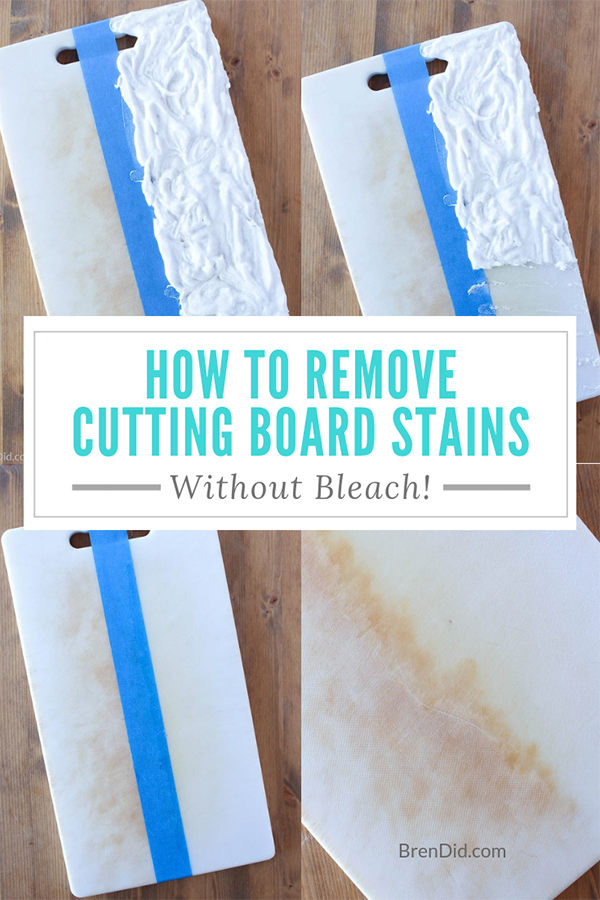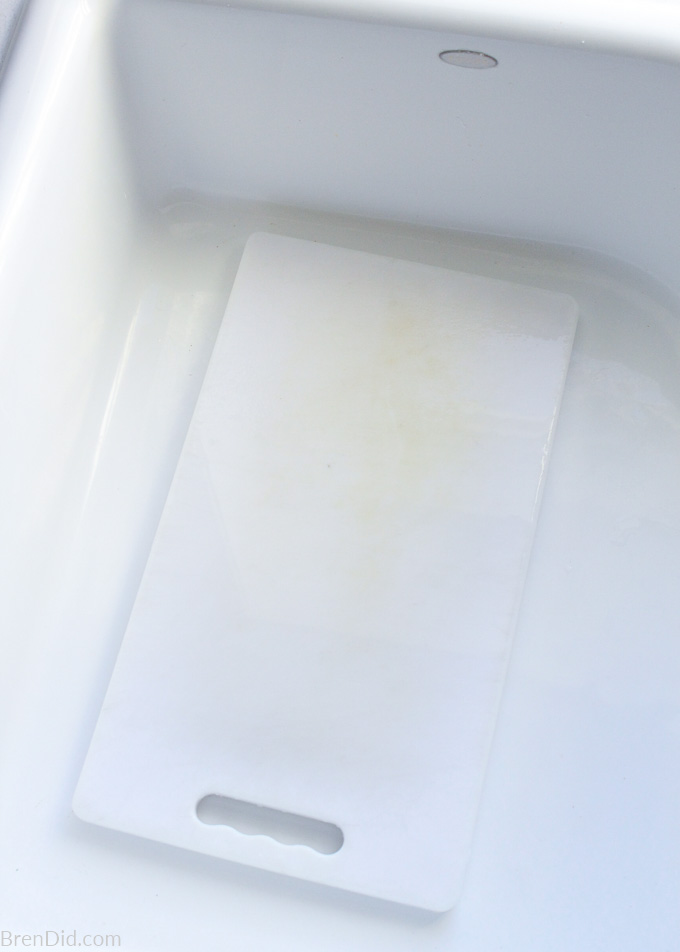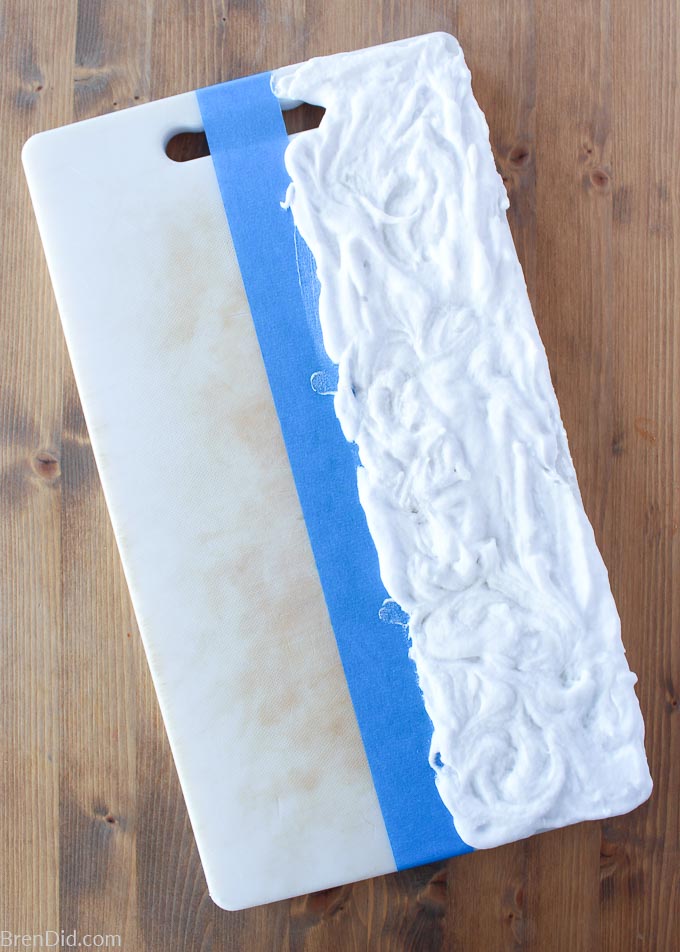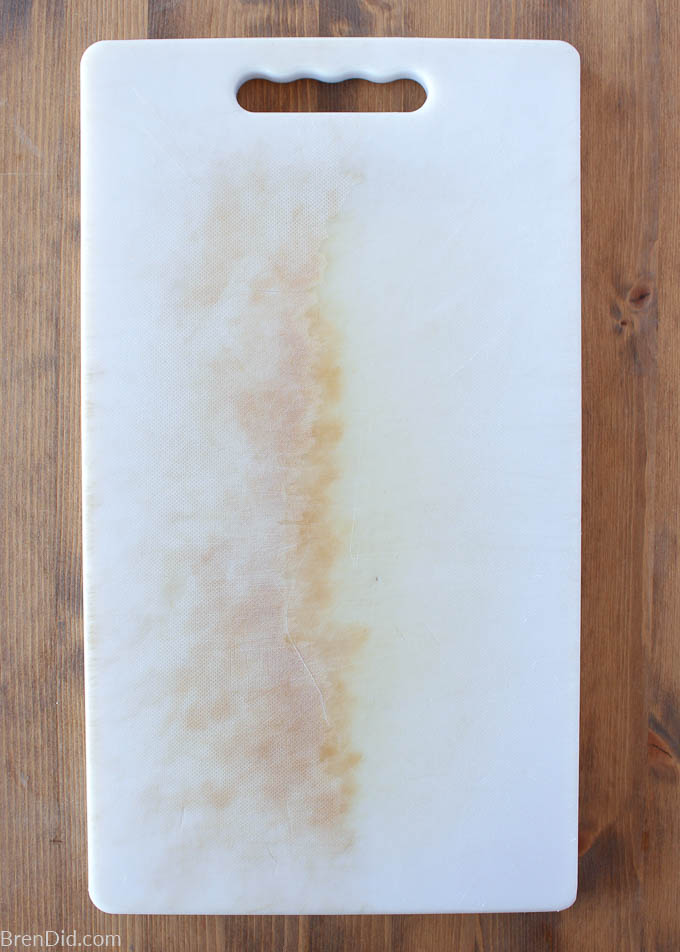How To Clean Coffee Stains From Plastic
Has your plastic cut board seen better days? Learn how to remove stains from plastic cutting boards with hydrogen peroxide, baking soda, and dishwashing detergent. Easy, green cleaning tutorial.

I have a white plastic cutting board that I use for cut meat and poultry. It's easy to store and can be popped into the dishwasher for easy clean-up and disinfection.
The downside to plastic cutting boards… they seem to become discolored or stained after just a few months (or weeks) of employ.
Oh, how I hate those disgusting brown stains that cannot be scrubbed away!
Luckily, I've discovered 2 piece of cake ways to get stains off plastic cutting boards, no bleach needed!
How to Remove Stains from Plastic Cutting Boards
There are two easy ways to remove stains from cutting boards:
- Hydrogen peroxide soak.
- Blistering soda, hydrogen peroxide, and dish detergent paste.
 How to use hydrogen peroxide to remove cutting lath stains
How to use hydrogen peroxide to remove cutting lath stains
Plain old 3% hydrogen peroxide volition bleach away cutting board stains if given enough dwell time.
- Lay the cut board in a sink.
- Spray or pour hydrogen peroxide over the cutting board until information technology is wet.
- Allow the hydrogen peroxide to soak for several hours or overnight. (You should see the stain lighten considerably.)
- Wash the cut lath with detergent and water, let to dry.
Why this method works:Hydrogen peroxide is a natural bleaching agent that brightens surfaces and kills bacteria. Giving the hydrogen peroxide several hours to work on the stain is key.
 How to use blistering soda, hydrogen peroxide, and detergent to remove cut board stains
How to use blistering soda, hydrogen peroxide, and detergent to remove cut board stains
Mixing hydrogen peroxide with dish detergent and blistering soda makes an piece of cake to apply paste that bleaches abroad cutting board stains.
- Make a paste from 3-4 tablespoons of blistering soda, 1 tablespoon of dish detergent, and 1-2 tablespoons of hydrogen peroxide. The mixture should be easily spreadable but non soupy.
- Spread the cleaner all over ane side of the cut board and allow to sit down for several hours or overnight
- Wipe or rub off the cleaner, wash the cutting board with detergent and water, and allow to dry.
Why this method works:
- Hydrogen peroxide is an effective bleaching amanuensis that bleaches stains, brightens surfaces, and kills bacteria.
- Dish soap cuts through whatever greasy residue left on the cutting board.
- Blistering soda is a natural abrasive that helps to break downwards nutrient stains. (I likewise employ information technology to clean my oven!)
- The thick mixture keeps the cleaning agents in place on the cutting board long plenty to remove the cut board stains.
Why Yous Should Clean Plastic Cutting Boards Without Bleach
Many people use bleach to clean plastic cutting boards. They choose bleach because it is good at removing stains and kills germs.
Unfortunately, cleaning with bleach can impairment your wellness and corrode surfaces.
- Bleach is a sodium hypochlorite solution which is dangerous to inhale, irritating to the skin & eyes, and toxic to swallow.
- Bleach is a strong base of operations with a pH of around 12. Considering of its loftier pH bleach is corrosive to materials it touches, including plastic.
- Most tutorials for removing cutting board stains with bleach use undiluted bleach. This advice goes against the manufacturers' recommendations (Clorox recommends using only i tablespoon of bleach mixed with 1 gallon of water on food preparation surfaces.)
Luckily hydrogen peroxide tin can be used to remove plastic cutting lath stains safely, without harm!
- Hydrogen peroxide is often called "oxygen bleach". Information technology is a neat stain remover, surface brightener, and leaner killer.
- Unlike chlorine bleach, hydrogen peroxide is not corrosive to surfaces and is non-toxic.
- Later use, hydrogen peroxide naturally breaks down into oxygen and water.
How to Sanitize Plastic Cutting Boards Naturally
Plastic cutting boards are fabricated of non-porous material that makes them safer for nutrient preparation. However, there are some situations when you many want to sanitize your plastic cutting board (after cutting upward meat, etc.)
Use 1 of these methods to naturally disinfect a plastic cut board:
- Run the cut board through the dishwasher on the hottest setting. The heating element in the dishwasher heats the water above the temperature your skin can tolerate, killing more bacteria.
- Wash the cutting lath with soap and water then wipe or spray the cutting lath with white vinegar. Side by side wipe or spray the cut board with hydrogen peroxide. Rinse clean. This 1-two punch will naturally kill bacteria lingering on the cutting board. Information technology works equally well as bleach.
Skip the bleach and shop-bought cleaners for cutting board stains and try hydrogen peroxide. It's an like shooting fish in a barrel, light-green way to remove stains and go along your cutting boards looking dandy!
Like green cleaning tutorials? Sign up for my newsletter beneath and never miss a thing!

Bren Did Newsletter Subscribers Get Access!

Thanks for subscribing to Green Cleaning & Natural Body Intendance updates! Cheque your e-mail to confirm your subscription.
Reader Interactions
Source: https://brendid.com/how-to-remove-stains-from-plastic-cutting-boards/
Posted by: coxhusloncom.blogspot.com



0 Response to "How To Clean Coffee Stains From Plastic"
Post a Comment